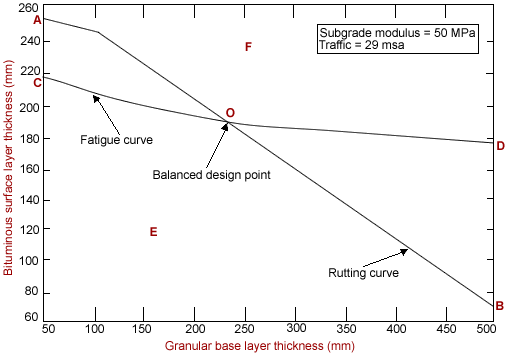Design Principle Based
This section discusses about the design principle based innovative applications of road materials. Discussion has been divided into two parts viz.,
- Structural design considerations, and
- Mix design considerations
Optimum pavement design thickness
In Mechanistic-Empirical pavement design, generally sustainability of a pavement structure against fatigue and rutting failures is considered, for which the critical responses are: (a) the tensile strain at the bottom fibre of bituminous layer and (b) the vertical strain at the top of the subgrade. A number of design thickness combinations of bituminous and granular layers are possible which satisfies the above mentioned requirement.
Standard design charts developed by various organizations (Shell 1978; Austroads 1992; Asphalt Institute 1981; IRC:37-2001) are available; these design charts generally provide thickness composition of bituminous and granular layers, depending upon other input parameters viz. temperature,
traffic, design life, subgrade strength, material
type etc. A designer can choose any suitable granular
layer thickness, and, corresponding thickness of
bituminous layer can be read from these charts.
 |
Figure 10. Typical pavement design chart |
POINT A - Safe from rutting but oversafe from fatigue considerations.
POINT B- Safe from rutting but unsafe from fatigue considerations.
POINT C- Safe from fatigue but insafe from rutting considerations.
POINT D- Safe from fatigue but oversafe from rutting considerations.
POINT E - Unsafe from both rutting and fatigue considerations.
Point F- Oversafe from both rutting and fatigue considerations
POINT O- Just safe from both rutting and fatigue considerations.
Figure 10 illustrates
a typical design chart. The design chart consists
of two curves: fatigue curve and rutting curve. The
fatigue curve shown as COD
in Figure 10 represents the points, which
are just safe from fatigue consideration. Similarly,
the rutting curve shown as AOB
in Figure 10 represents those points which
are just safe from rutting consideration. Figure
10 shows various points like A, B, C, D, etc. They
are safe, oversafe or unsafe from fatigue or rutting
considerations. The reader can point the cursor on
the respective points to know about their status.
In the design chart the fatigue curve and the rutting
curve intersects at a point (point O in this case)
that may be called as structurally balanced design
point (Narasimham,
et al., 2001). Thickness of pavement layers
chosen according to this point will result in a pavement
deign which would fail due to fatigue and rutting
simultaneously. Similarly, there could
be cost optimal point, where bituminous and granular
layer thicknesses are selected such that the total
cost of materials used is minimized, without compromising
with the structural adequacy of the pavement. The
cost optimal point may or may not coincide with the
structurally optimal point (Narasimham
et al. 2001, Das 2004 ).
|